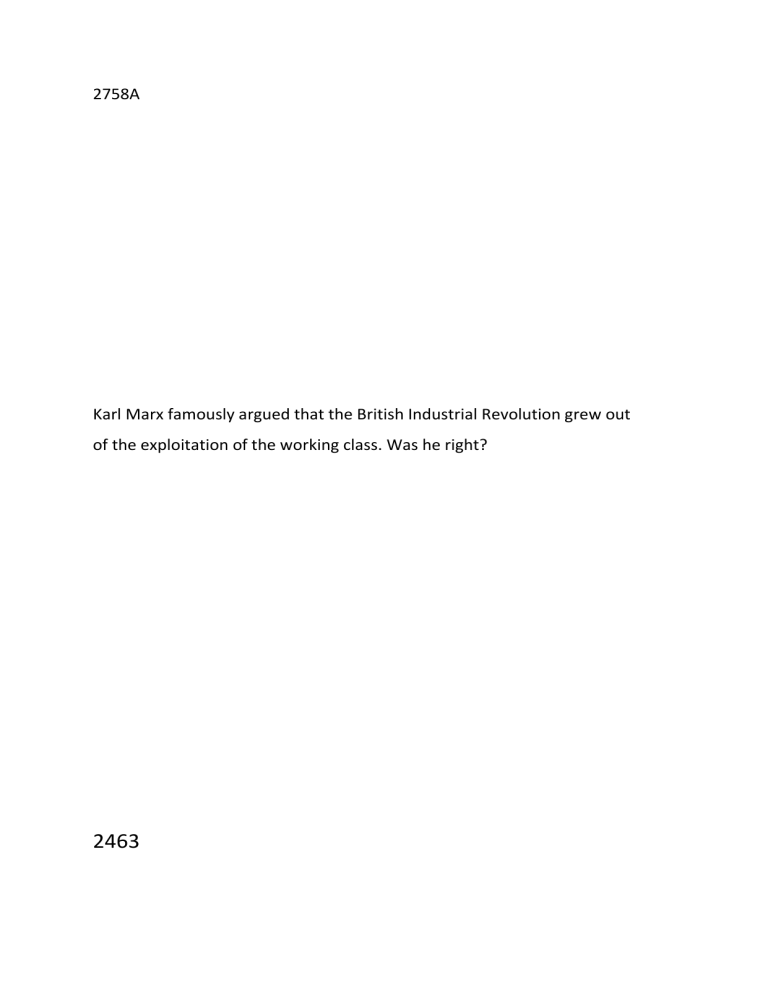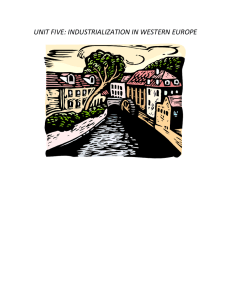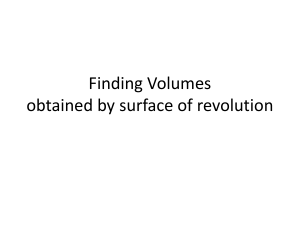
2758A Karl Marx famously argued that the British Industrial Revolution grew out of the exploitation of the working class. Was he right? 2463 The industrial revolution (circa 1750- 1850) originated in Britain and was characterised by substantial, sustained economic growth. It was the first time in history the Malthusian trap was overcome, allowing population and economic growth to accompany one another in their expansions. Technological development and subsequent implementation in society provide the only explanation for this persistent economic growth, as supported by the Solow Swann model. This is because capital accumulation which causes short-term economic growth, eventually runs into diminishing returns, preventing sustained, long-term economic growth and improvements in prosperity to take place. Therefore, in verifying the integrity of Karl Marx’s argument for the cause of the industrial revolution, initially identifying how the exploitation of the working class leads to technological advancements in society is vital. Karl Marx argues that individuals with no ownership of the factors of production, known as the working class, were exploited by those that did in order to onset the industrial revolution. The ‘bourgeoisie’, those in charge of the factors of production in society, were then able to generate substantial profits that could be re-invested into the technologies circulating the market, to help sustain the continuation of the industrial revolution. However, this technological implementation is dependent on the presence of a ‘high-wage society’, for owners to have some incentive to implement new expensive technologies in their production methods. Therefore, the argument, synthesised by Allen, that a high-wage economy was essential for the onset of the industrial revolution is of important consideration. Although, the extension of exploited individuals in Karl Marx’s argument, to not just those in Britain but also those in British colonies, such as the slaves in North America, more conclusively supports the emergence of the industrial revolution. This is because the triangular trade for which slaves were an essential part of, enabled luxury, exotic goods to be imported to Britain, and aid an ‘industrious revolution.’ (Vries, 2008) Although the exploitation of working-class individuals was significant, it was arguably not sufficient in onsetting the industrial revolution. Instead, it was a consequence rather than a cause of the industrial revolution that along with other factors, helped sustain its presence for the 100 years it spanned. The working class, which Marx establishes as the exploited individuals amidst the industrial revolution, arose from the enclosure acts passed in parliament that privatised communal land. As a result, commoners could not use this land for foraging, hunting and subsequently sustaining their livelihoods, which relied significantly on the gains from these communal lands. This was particularly significant for women and children who ‘were the primary exploiters of common rights,’ (Humphries, 1990) and as Humphries identifies, families became more vulnerable to exploitation due to their now increased reliance on the small wages they earned as a consequence. Being left with no means of production, many families migrated to urban cities, where work opportunities were more abundant. However, with little bargaining power and extreme desperation, the working class were easily exploited, as suggested by the 23% increase in working hours a day to 10.5/11 hours during 1750-1800. (Voth, 2001 ) Although, it is important to acknowledge that the vulnerability of the working class does not directly imply that these individuals were exploited. Instead, the longer, harder hours of work they engaged in may have been a voluntary contribution to increase their consumption possibilities which De Vries acknowledges as the emergence of an ‘industrious revolution.’ (Vries, 2008) Regardless, the working class became, ‘merely the motive power of an implement-machine.’ (Marx, Capital: A Critical Analysis of Capitalist Production, London 1887, 1967) Working-class individuals were ultimately essential in the operation of machineries, such as the steam engine and plough, which induced productivity improvements and sustained the industrial revolution. Moreover, they were important in showcasing that technology could be appropriately used once implemented, encouraging and reassuring business owners about the further mechanisation of industrious jobs. However, the automation of jobs is, more importantly dependent on high wages for labour, a necessary condition, that Allen believes is unique to Britain and a causal factor in both onsetting and sustaining the industrial revolution. This is because if wages are high then technological innovation and subsequent implementation are encouraged to act as a substitute for the expensive labour to make production more profitable, which is the main motive for firms. (Allen, 2009) Therefore, although the supposed exploitation of working-class individuals was somewhat influential in supporting the industrial revolution, it was not a sufficient factor in aiding technological innovation or implementation to respectively either onset or sustain the continued presence of the industrial revolution. Arguably the British industrial revolution grew not from the exploitation of the working class, but rather from the high labour cost that meant, ‘British Workers were more prosperous than their counterparts,’ (Allen, 2009) which is exemplified by the ‘widespread consumption of expensive and highly refined foods like white bread, meat, dairy products and beer,’ (Allen, 2009) in Britain. With the presence of high labour costs, incentives for firms to increase returns by implementing ‘labour-saving technological’ changes were established, which aided the movement of inventions from the market to the workplace. The ability for high wages to incentivise greater technological advancements that generate substantial profits enabled firms to pay higher wages, in turn creating additional productivity improvements. This created a virtuous cycle that mutually reinforced high wages and high productivity aiding substantial economic growth, like that seen during the industrial revolution. This virtuous cycle was also reinforced by an alternative route where the endogeneity of higher wages yielded higher levels of education that supported the development of a more intelligent and scientific society. (Allen, 2009) Through a revolution in ideas, which Mokyr refers to as ‘the enlightenment’ (Mokyr, 2009), involvement in business, invention and economic activities that improved social standing in society, were seen as respectable, encouraging increased participation in the market, further aiding the technological advancements responsible for the industrial revolution. Unlike Marx’s explanation for the industrial revolution which relied on the direct channel of profit creation through the exploitation of working-class individuals to encourage technological implementation, Allen’s argument of a high wage economy evidently operates through multiple channels. These include education, ideas, as well as profit creation, that in turn reinforce one another, but also more conclusively cause rather than encourage increased automation. However, data on these proposed high wages in Britain are limited, failing to ensure that high wages were present throughout the entirety of Britain and not just polarised in particular favourable geographic locations, like port cities and London. This issue with the integrity of the evidence supporting Allen’s argument has been pointed out by many other economic historians like Judy Stephenson who uses new evidence from construction sites to argue that wages for workers in Britain were low on the eve of the industrial revolution. Although Stephenson finds that ‘the actual wage in London construction was significantly below the levels reported in the series that have been used by Allen,’ this conclusion is synthesised just based on data restricted to Construction in London. Additionally, Stephenson fails to consider whether these newly revised wages were still high in comparison to the rest of the world, which Allen points outs to conclude her adjustments ‘would have no significant implications,’ (Stephenson, 2018) as British wages were still higher than anywhere else in the world after these revisions. Unlike Marx’s theory for the cause of the industrial revolution, Allen’s argument is more robust in the sense that it provides a reasonable explanation as to why the industrial revolution was onset but also why it was unique to Britain, which the industrial revolution initially was. Identifying whether individuals were exploited is difficult as the data is ambiguous, supporting both the idea of individuals being exploited but also that individuals chose to work harder and longer in response to the expanding consumer market. Whereas Allen’s argument identifying whether real wages were high is contested by economic historians that believe there is insufficient evidence to make this claim, but nevertheless supportive of the fact that high wages were present. Therefore, although this does not disprove Marx’s theory about the industrial revolution it suggests that the exploitation of individuals was less important in aiding the onset of the industrial revolution than high wages for labour were. However, if the definition of exploited individuals during the industrial revolution is extended to not just those present in the domestic economy, but also the slaves in British colonies that arguably were more significant in the onset of the industrial revolution, then this significantly improves Marx’s argument. There is no ambiguity about the exploitation of slaves, whose human freedoms were completely abolished once they were sold. They were forced into the production of goods like, cotton and tobacco, working ‘shifts of up to 18 hours a day’ (BBC , 2022). They were essential in the production of these raw materials that were imported to Britain and supported the changing nature of exports. Increased production of finished goods was being undertaken due to the availability of abundant raw materials from the Americas, requiring production itself to become much more centralised. There was a movement away from household production to operating in factories, where labour could be divided to enable increased efficiency through specialisation and support the export-led growth of this period. Overall exports increased from £1,141,000 in 1699/1701-1772/74, to £2,614,000 in 1772/741804/06 (Inokori, 2002), as an intricate, triangular network of trade developed across the Atlantic Ocean. British manufactures were sold in Africa in exchange for slaves that were sold to planters in the Americas. The slaves produced ‘plantation crops – sugar, cotton, indigo, cocoa,’ (Williams, 1994) that were sold also in exchange for British manufactures. This gave a ‘triple stimulus to the British economy,’ (Williams, 1994) increasing capital accumulation that could be re-invested into technological improvements for production in order to maintain and expand Britain’s trading position. This is supported by Inokori’s own belief that the ability to export sustains growth, as ‘increases in overseas sales accounted for more than half of the increments in British industrial output between 1700 and 1760, and between 1780 and 1800, respectively.’ (Inokori, 2002) This is because as trade becomes more prominent, incentives to ease and improve the processes required to produce the goods for exportation was desirable, particularly given the substantial profits that could be made. Consequently, technological implementation occurred. Inokori’s view on the importance of overseas resources in increasing export sales that encouraged technological change is complementary with Pomeranz’s theory about the onset of the industrial revolution. Pomeranz emphasises how the absence of overseas resources would have forced Britain ‘back onto a path of much more labour-intensive growth,’ (Pomeranz, 2000) making the slaves, who were responsible in producing resources for international trade, extremely significant. However, despite this William believes that while slavery was an initial driver it became less critical as the British Industrial revolution wore on and technology advanced. (Williams, 1994) However, Marx himself acknowledges that ‘world trade is the necessary condition for large-scale machine industry.’ (Marx, The Poverty of Philosophy, 1846) In particular, it is the slaves, exploited black individuals, that were essential for strengthening Britain’s trade position, and as Marx points out, ‘Without slavery there would be no cotton, without cotton, there would be no modern industry.’ (Marx, The Poverty of Philosophy, 1846) Although this is not Marx’s main belief for why the industrial revolution was caused, it can be incorporated within his thesis to strengthen his argument. This is partially because there is no doubt as to whether slaves were exploited like there is about working-class individuals, but more importantly because it more definitely results in the technological advancements that aided the industrial revolution. This is because, in addition to the technological advancements encouraged by the supply-sided economic growth from international trade that slaves were responsible for, technological improvements also arose from demand-side factors made possible by slavery. With the substantial profits generated from the triangular trade system, much more luxury foods and goods were being imported to Britain. As individuals became increasingly aware of these new delicacies that were now being introduced to British markets, they subsequently chose to work longer and harder so they too could consume these products, aiding an ‘industrious revolution.’ (Vries, 2008) This is significant because when individuals are incentivised to work harder and longer, they become more creative in the manner they complete their required jobs to make it more manageable, in due course aiding improvements in productive efficiency through incremental technological developments required for their jobs. Although the extent to which regular working-class individuals were able to influence the creation of macro-inventions that onset the industrial revolution was minimal, it still had a small, supportive role in the industrial revolution by causing some productivity improvements to existing industrious jobs. As a result, this showcases that Marx’s thesis focuses on the exploitation of the wrong group of people, who may have not even in fact been exploited, but also were not as influential in onsetting and supporting the industrial revolution as slaves were. Overall, Marx was to some degree incorrect about the fact that the industrial revolution grew out of the exploitation of working-class individuals. Firstly, there is limited evidence to support the fact that individuals were being exploited and not voluntarily choosing to increase their participation in markets. Moreover, even with individuals being exploited, this is neither a necessary nor sufficient factor in causing technological advancements that caused the industrial revolution. Although it was to some extent influential as it ensured that machineries were operated once in use, this did not provide a strong incentive for firms to automate. Instead alongside this, wages for labour must have been high in order to have ensured that firms would implement labour substituting technological changes that could cause sustained economic growth. Consequently, Allen’s theory as to why the industrial revolution was caused and sustained is more robust than that proposed by Marx. However, extending Marx’s argument to incorporate slaves, who were without doubt significantly exploited provides a more reasonable explanation for the cause and continuation of the industrial revolution. Slaves were integral in the expanding international trade of this period, that as Inokori points out was significant in the technological developments that subsequently followed. Therefore, Marx was on the right tracks when he was considering the exploitation of individuals, just incorrect in the group of people he focused on, the working class in the domestic economy. However, in regard to Allen’s high wage theory, the presence of slavery is still secondary in causing the industrial revolution as although this factor is sufficient it is not necessary in comparison to a high wage economy, which is both these conditions. Therefore, although the exploitation of individuals was influential in the industrial revolution and in particular in regard to slaves, high wages for labour is arguably the crucial condition that caused as well as sustained the industrial revolution. Bibliography Allen, R. (2009). The British Industrial Revolution in global perspective . New York : Cambridge University Press . BBC . (2022, May 2). The captives' experience and resistance to enslavement. Retrieved from BBC Bitesize : https://www.bbc.co.uk/bitesize/guides/z732pv4/revision/3 Humphries, J. (1990). Enclosures, Common rights, and women: The Proletarianization of families in the late eighteenth and early nineteenth centuries . The Journal of Economic History , 17-42. Inokori, J. E. (2002). Africans and the industrial revolution in England . Cambridge : Cambridge University press. Marx, K. (1846). The Poverty of Philosophy. New York: International publishers . Marx, K. (1967). Capital: A Critical Analysis of Capitalist Production, London 1887. New York : International Publishers . Mokyr, J. (2009, April 29). The enlightened economy . Yale : Yale university press . Retrieved from UK Parliament: https://www.parliament.uk/ Pomeranz, K. (2000). The great divergance . Princton : Princton university press. Stephenson, J. (2018). Real Wages? Contractors, workers, and pay in London building trades, 1650-1800. The Economic History Review , 106-132. Voth, H.-J. (2001 ). The longest years: New estimates of labor input in England, 1760-1830. Journal of Economic history 61, 1065-1082. Vries, J. D. (2008). The industrious revolution . Cambridge : Cambridge university press . Williams, E. (1994). Capitalism and Slavery . Chicago : University of North Carolina Press .


